Indoor biking is trendy AF right now (hi, Peloton), but stationary bikes can also be pricey AF. Plus, if you’ve already invested in a bicycle for riding outdoors, the price tag attached to a stationary bike can feel even harder to justify.
But what if you could turn your bike into a stationary bike? Well, with bike trainers — which primarily consist of a stand that clamps to the rear wheel of your bike — you can. (Woot!)
Here are the six best bike trainers for beginners, advanced riders, and everyone in between.
6 best bike trainers for 2021
- Best overall bike trainer: Sportneer Bike Trainer Stand
- Best bike trainer for travel: Alpcour Magnetic Bike Trainer
- Best bike trainer for beginners: Sportneer Indoor Fluid Bike Trainer
- Best bike trainer for advanced riders: BalanceFrom Bike Trainer Stand
- Best budget bike trainer: Yaheetech Magnetic Bike Trainer Stand
- Best luxury bike trainer: Saris CycleOps Fluid2 Indoor Bike Trainer
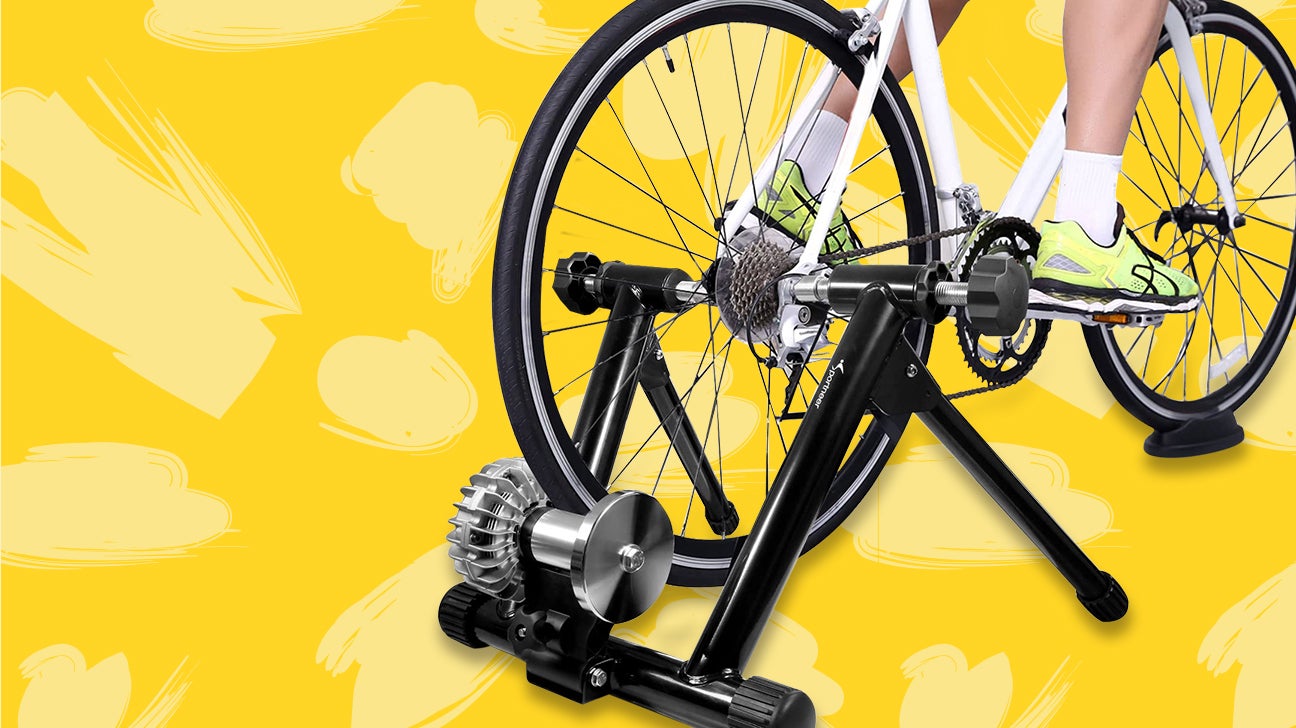
How we chose the best of the best
We based our recs on customer reviews and tips from Jamie Bacharach, a health coach at Maple Holistics. Here are the criteria we focused on when making our selections:
- Price. We chose bike trainers that are relatively cheap (under $500) so they’re accessible to more people.
- Durability. The best purchases are those that prove hardy, and bike trainers are no exception. No one wants a product that instantly starts to break down.
- Ease of use. Some bike trainers have more moving parts (literally) than others and can be harder to set up and operate. We opted for some simpler options that are easier to use.
- Noise level. Bike trainers can be notoriously noisy, so we made sure to pick ones that won’t make your ears bleed or annoy your neighbors. Fluid trainers and magnetic trainers, for example, cause less of a ruckus than wind trainers (more on that later).
- Stability. When you’re teetering atop a bike seat, the last thing you want is to take a tumble. We chose trainers that’ll stay firmly planted as you pedal in place.
Pricing guide
- $ = under $100
- $$ = $100–$200
- $$$ = over $200
The best bike trainers
Best overall: Sportneer Bike Trainer Stand
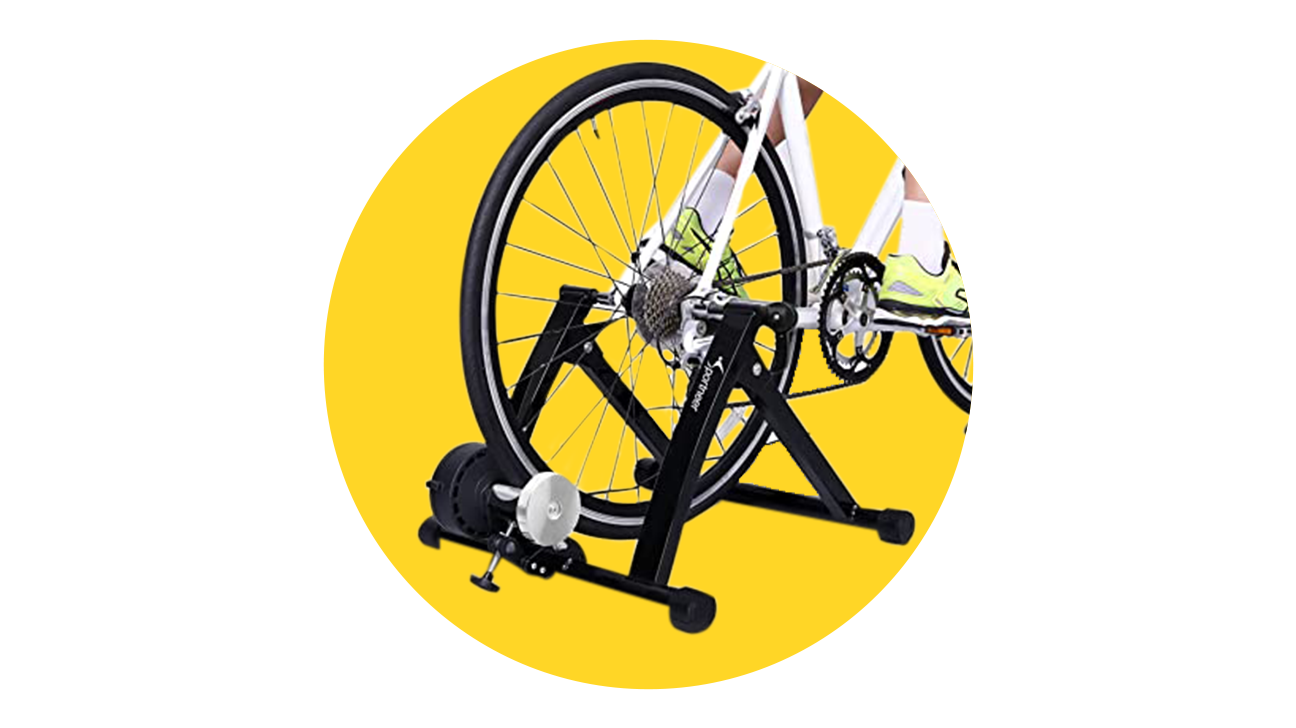
- Price: $$
- Trainer type: Wheel-on
- Resistance type: Magnetic; 6 settings
- Smart/connected: No
- Gear included: Front wheel riser block
This Sportneer model is hella popular, with a 4.4 rating on Amazon from more than 5,000 reviews. Reviewers say it’s user-friendly and easy to assemble, and they highly recommend it.
It has a wide base, a low stance (meaning it sits low to the ground), and anti-slip rubber foot pads, all of which is supposed to make it super stable. It also has six resistance settings to spice up your ride.
The only downside is that some reviewers say it can be a bit loud, depending on the tires on your bike.
Best for travel: Alpcour Magnetic Bike Trainer Stand
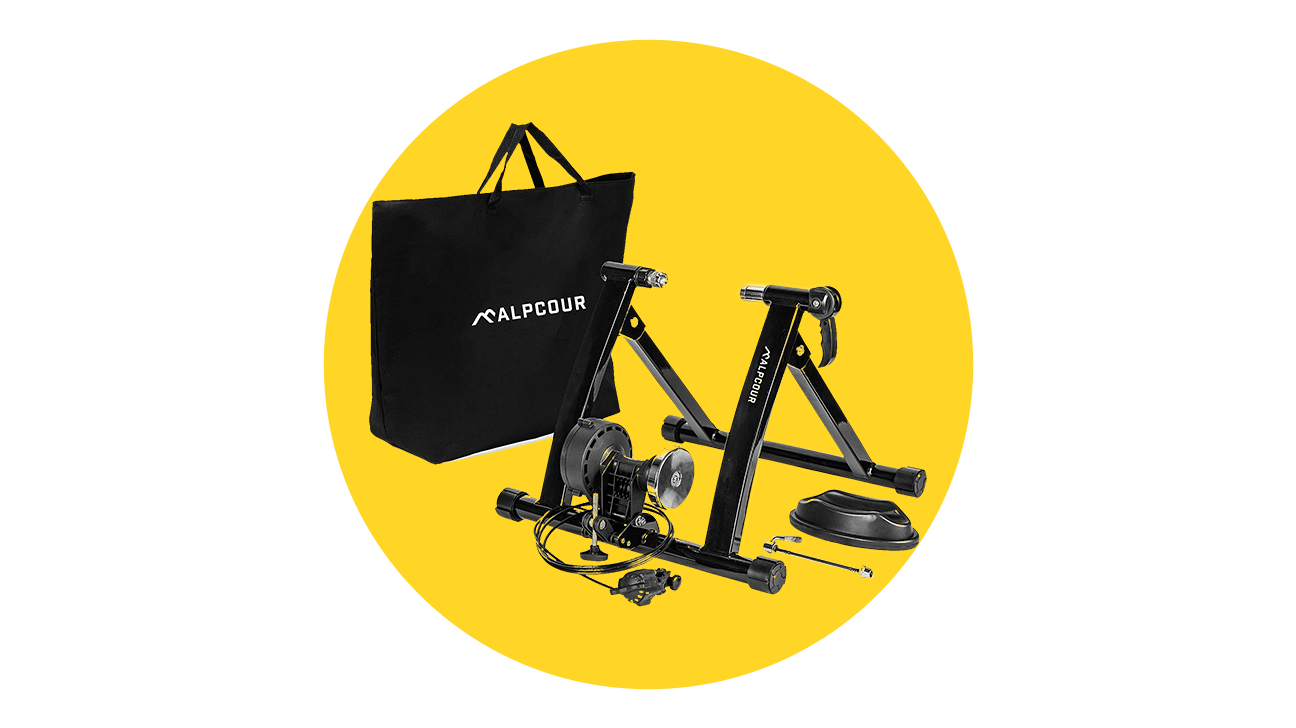
- Price: $$$
- Trainer type: Wheel-on
- Resistance type: Magnetic; 6 settings
- Smart/connected: No
- Gear included: Front wheel riser block, accessory bag, carry bag
Reviewers say this bike trainer is pretty lightweight and folds up easily. It’s also supposed to be really quiet and doesn’t require any tools for setup. Another plus? It comes with a bag for easy transport, so you can pack it up and use it wherever you and your bike may go.
Best for beginners: Sportneer Indoor Fluid Bike Trainer

- Price: $$
- Trainer type: Wheel-on
- Resistance type: Fluid; not adjustable
- Smart/connected: No
- Gear included: Front wheel riser block, accessory bag
This model from Sportneer has a stainless steel frame that’s built to be as tough as nails. It doesn’t have adjustable resistance, so it’s def a better pick if you’re just looking to use your bike’s gears as resistance.
Reviewers say it’s really stable (so you won’t wobble, baby) and super easy to set up. It’s also compatible with a wider range of bike sizes than most other bike trainers.
Best for advanced riders: BalanceFrom Bike Trainer Stand
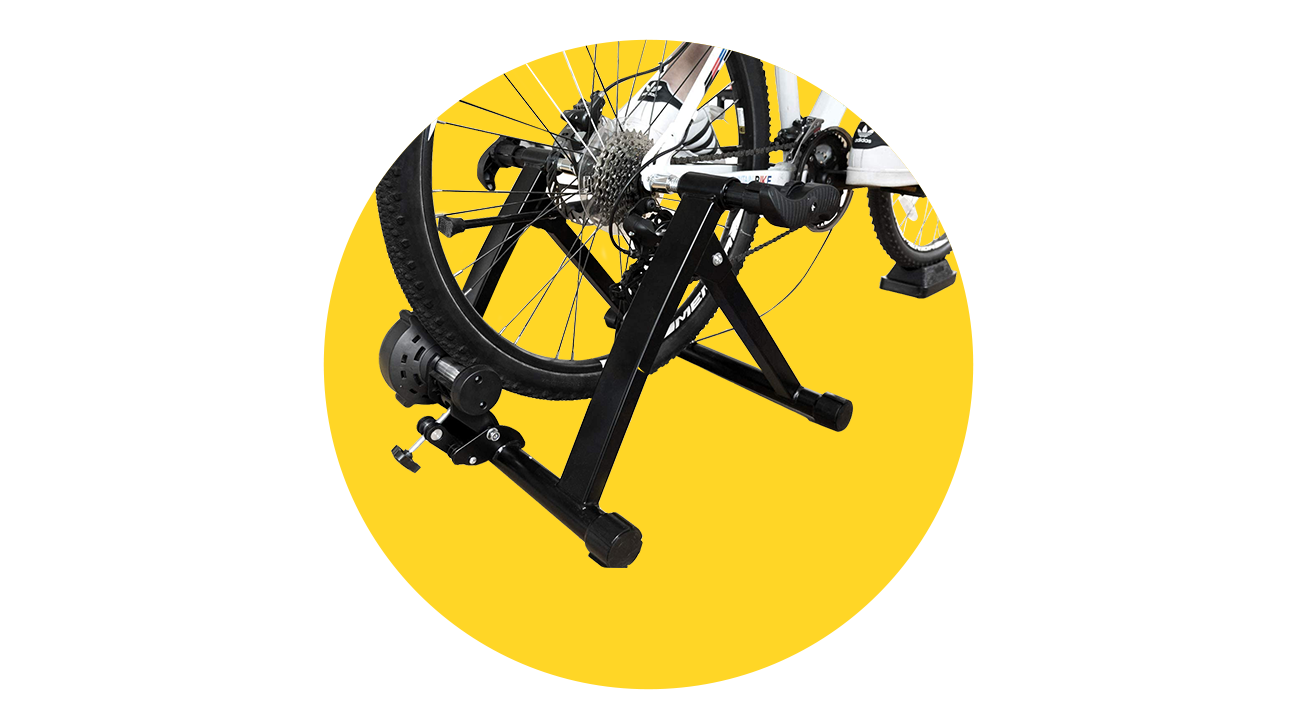
- Price: $$
- Trainer type: Wheel-on
- Resistance type: Magnetic; 8 settings
- Smart/connected: No
- Gear included: Front wheel riser block
This BalanceFrom trainer is pretty heavy-duty. It can support up to 330 pounds and has eight — count ’em, eight — resistance settings, so you know it’s tough, reliable, and versatile enough to quite literally go the distance with you.
Reviewers say it can be noisy when paired with a mountain bike rather than a road bike, so noise-canceling headphones are def recommended.
Best budget: Yaheetech Magnetic Bike Trainer Stand
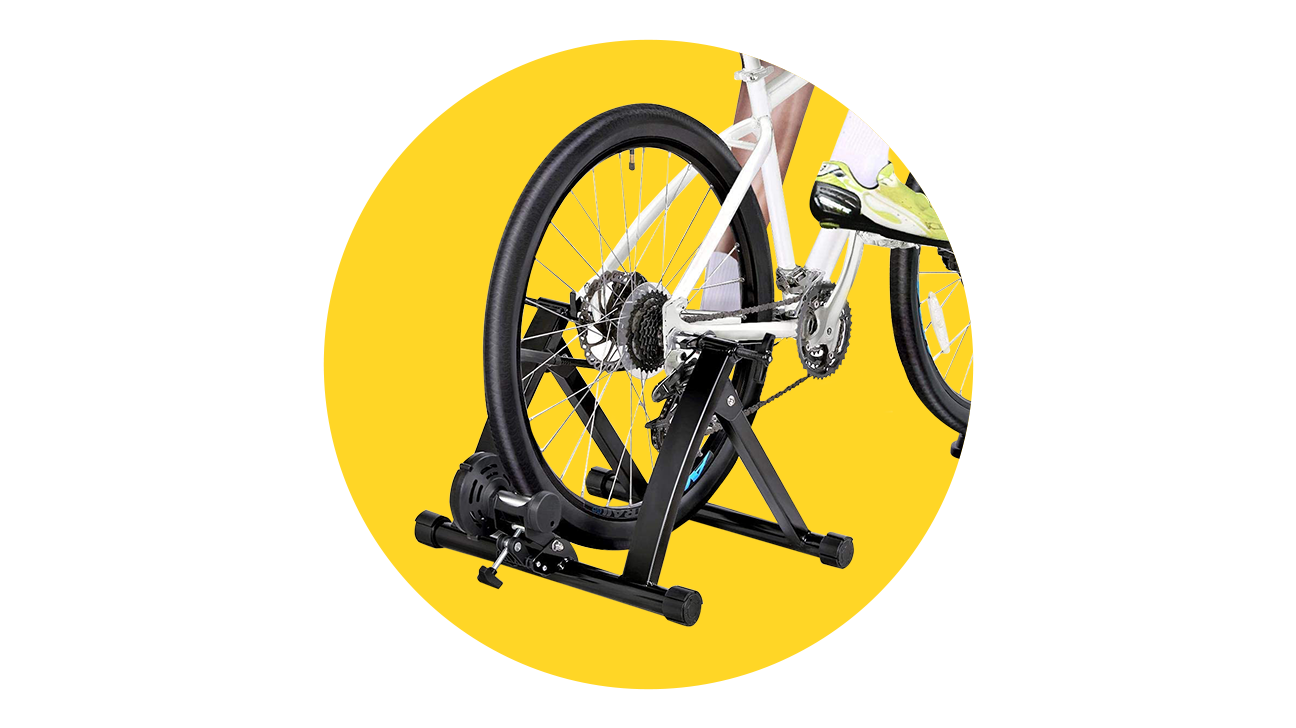
- Price: $
- Trainer type: Wheel-on
- Resistance type: Magnetic; adjustable screw
- Smart/connected: No
- Gear included: Front wheel riser block
The Yaheetech is a strong, durable, no-frills pick — but according to reviewers, it’s not the quietest bike trainer around. To adjust its resistance, you have to tighten a screw on the base. BUT the price point is a huge sell. If you’re looking for a cheap, basic bike trainer that gets the job done, this is for you.
Best luxury: Saris CycleOps Fluid2 Indoor Bike Trainer
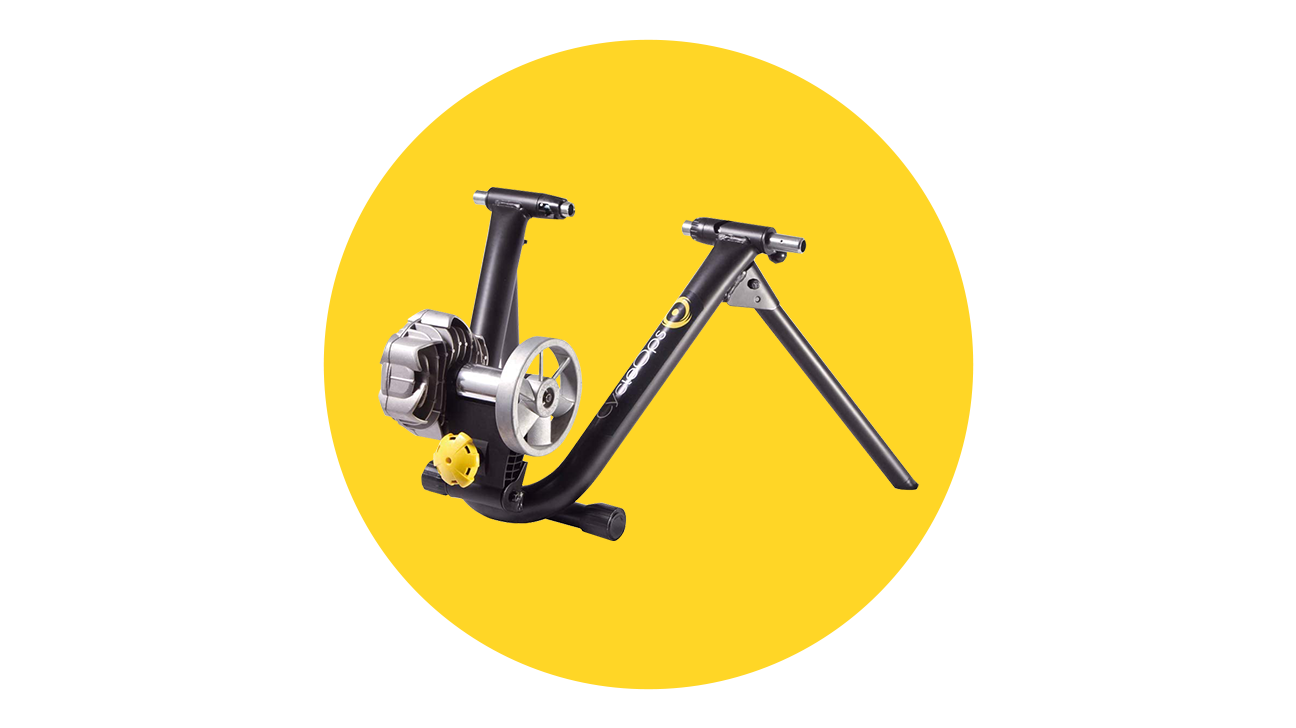
- Price: $$$
- Trainer type: Wheel-on
- Resistance type: Fluid; not adjustable
- Smart/connected: Yes
- Gear included: None
The Saris can hook up to fitness apps like Zwift and Rouvy to track your progress as you sweat your way toward the proverbial finish line — a huge plus for folks trying to find a happy medium between a bike and a stationary bike. It’s also supposed to be really quiet because it uses fluid resistance.
The only downside is that it doesn’t have resistance settings, so you’ll have to use the gears on your bike to make your ride harder.
Types of bike trainers
- Wheel-on trainers. The trainer attaches to your bike’s rear wheel. There are three versions:
- Wind trainers. These use wind resistance, but they’ve become less popular in recent years because they’re loud AF.
- Magnetic trainers. These use magnetic resistance and are pretty quiet — but they’re also more expensive than wind trainers, and their resistance settings tend to be limited.
- Fluid trainers. These use fluid resistance and are the quietest — and priciest — of all wheel-on trainers.
- Direct-drive/wheel-off trainers. These trainers come with a wheel to take the place of the one on your bike.
- Pivot trainers. These allow you to sway back and forth on your bike, simulating the experience of riding on an actual road.
- Roller trainers. These don’t attach directly to your bike — and they’re pretty tough to balance on at first.
- Smart trainers. These can hook up to a device such as a computer or smartphone to track your progress in real time or supplement your ride with a virtual reality experience.
How to choose a bike trainer
Ready to bike in place? Here’s what to consider when looking for the right trainer for you:
- Bike type. Some trainers are designed with specific bike sizes and styles in mind. Always check product descriptions to make sure your bike and wheels are compatible.
- Price. Bike trainers can cost anywhere from $70 to $1,400. Get a clear idea of your budget before you start your search so you don’t get too carried away while shopping (we’ve all been there).
- Portability. Some bike trainers are collapsible, so you can take them with you almost anywhere. If you can’t bear the thought of going a few days without a cycling session (serious props to you), look for a trainer you can fold up so it fits easily into your backpack or carry-on.
- Tech capability. If you’re into seeing stats like calories burned and miles covered, consider springing for a smart or connected trainer that’ll clock your stats as you sweat. Just remember that these are usually pricier.
Other tips for using bike trainers
If you’re thinking about making bike training a lifestyle, a few extra accessories can help maximize your ride:
- Fans to keep you cool as you pedal. “A strategically placed fan or two (front and back) can be a real lifesaver,” Bacharach says.
- Speed and cadence sensors. These monitor your performance over the course of a cycling sesh.
- Water bottle cage. You don’t want to have to dismount to grab a drink.
- Wireless headphones, speakers, or a smart device stand. These can add some extra entertainment to your ride. “Some find it easier to train or work out this way, especially when they’re being deprived of the great outdoors,” Bacharach says.
- Cycling mat, yoga mat, or rug. Use it to dull the sound of the trainer rubbing against your rear wheel.
- Trainer tire. This is essentially a single tire attached to the trainer itself. This add-on comes highly recommended by Bacharach, who says it can significantly reduce your prep time and extend the life of your rear wheel.
The bottom line
A bike trainer turns your road or mountain bike into an indoor bike suitable for all seasons. It’s also a good way to hop on that stationary bike trend without breaking the bank.
These six options are a great place to start. Just make sure you know what price, type, and features you’re looking for so you can find the bike trainer that gets you moving (without going anywhere).


0 Commentaires